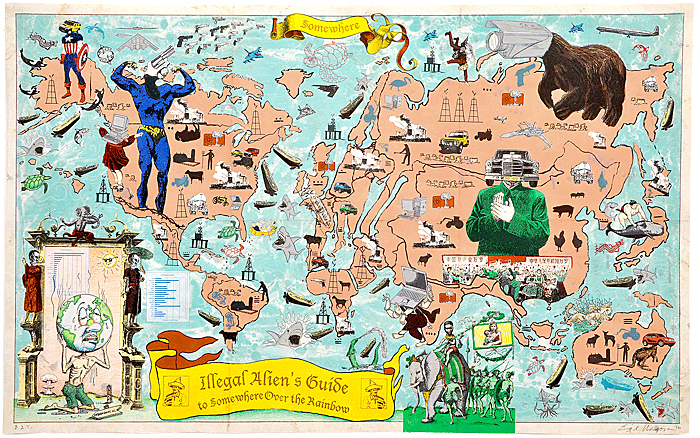
Enrique Chagoya in Loveland, CO
On Sunday morning if you were watching “This Week with Christiane Amanpour” you would have heard the bells of ancient (25-year-old) contemporary art history tolling. Gary Bauer of “Our American Values” (“protecting life, marriage, faith, and freedom” is the tag line), offered up that when back in the 1980s an artist suspended a crucifix in “a vat” of urine, Christians didnt “riot.” Maybe no, but the body blow to culture was extreme. Andres Serranos photograph Piss Christ, found Jesse Helms (R-NC) shaking a Xerox copy in the Senate chamber denouncing public funding for the arts. (The first nail in the NEA coffin.)
Lining up with the camp on “This Week” that opposes the so-called Ground Zero mosque contending that Muslim religion and violence are inextricable, Bauer used Piss Christ as a strange rhetorical crutch in an unsteady attempt to assert that Christians equal tolerance (when it comes to the arts, or life marriage faith and freedom.) We all can recall this years conviction of Scott Roeder, a born-again evangelical Christian (converted by a TV episode of The 700 Club in 1992) who killed gynecologist George Tiller outside Tillers (Lutheran) church in Wichita, Kansas.
And, when it comes to arts, the latest example of a fight over iconographic sanctity and blasphemy — now how is this so different from the Swedish cartoon issue? — has boiled up in Loveland, CO.

Enrique Chagoya's "Misadventures of Romantic Cannibals"
Enrique Chagoyas “The Misadventures of the Romantic Cannibals” (left) is being shown as part of an exhibition at the Loveland Museum/Gallery. According to a report in the Loveland Reporter-Herald, protesters were scheduled to gather (October 1) Friday morning at the art space to show their opposition to work that they consider obscene. Chagoyas multi-panel work shows “comic book characters, religious iconography and imagery, appropriated engravings, Mexican pornography, ethnic stereotypes, Mayan symbols” and more, according to the artists publisher, Sharks Ink.
The issue in Loveland is whether it shows Christ receiving fellatio. We reported on the Sharks Ink show when it appeared at MCA Denver in May 2009.
Fervid family-value Republicans have largely been key players in getting the government to back off arts funding in a way that has led to arts funding becoming only about big organizations and stabilization. Andras Szanto asserts that new art is “disruptive innovation”, and is at more risk than ever before.
The problem is that art””especially contemporary art””is, among other things, a form of disruptive innovation. That is precisely what makes art attractive to todays younger, enterprising benefactors. Moreover, art itself has been subjected to disruptive change. New technologies and globalisation are rapidly transforming not only the content of creative work, but also the modes of cultural participation that had remained more or less constant since the 19th century, until recently.
We havent figured out what permissive “cultural participation” is. A societal divide in our country in which art mavens are construed as “elitist” or politically “tone-deaf” co-exists indeed with increasingly threatening protests over images rights to be seen, circulated, interpreted, and by extension – artists rights to depict narratives that may be unorthodox. But if you consider that free speech allows for sides with “bias”- it follows that bias is a protected point of view. Thats why nuts threatening to act violently because of objections to biased speech need to be sidelined. Speech and arms are very distinct. But really: why have the arts been so singled out for prejudice when, among other evident American rights, one can choose to be evangelically converted on a TV show?
One of our respected journalism TV shows Sunday found political figures in America remembering the “international day of anger” a sheik urged to the Muslim world in 2008 after a Swedish newspaper published supposedly blasphemous cartoons of the prophet Mohammed. In its reporting the Guardian newspaper called this a “clash of civilizations.” And for us to pretend there isnt one here involving Christians and their iconography is false.
In New Mexico in 2001 that clash happened in the form of a Latina artist from Los Angeles (not so far away geographically, but clearly metaphorically removed), Alma Lopez, contributing a Virgen de Guadulupe to an art show called CyberArte. Protesters were bused in, as I reported at the time, with funding from arms of Opus Dei and other political groups with invisible chessmasters arranging a gameboard of symbolic culture warriors.
Chagoya in Loveland is the latest now in trouble, for work he made at Sharks Ink. A professor at Stanford, his work is in the public collections of institutions including the Los Angeles County Museum of Art, the Museum of Modern Art in New York, the Whitney Museum of American Art and the San Francisco Museum of Modern Art. All those entities will probably still continue to benefit from Szantos arts funding analysis of “stabilization.” But there are many American cities between those coastal ones. Where the circulation and freedoms of vitally disruptive images, is perhaps more important to the polity than ever.
(top image: Enrique Chagoya : “Illegal Aliens Guide to Somewhere Over the Rainbow”: 2010 Color lithograph w/chine collé : 24¾ x 40¾” : Ed. 30 : $3400)
